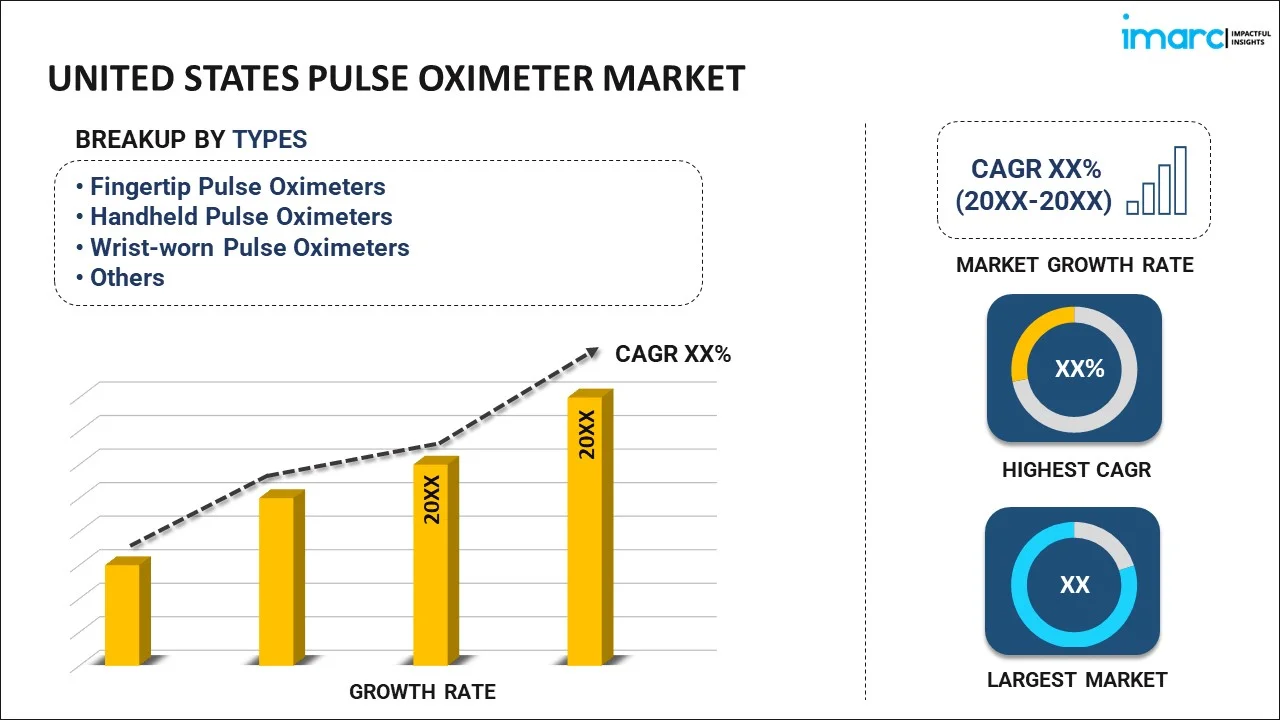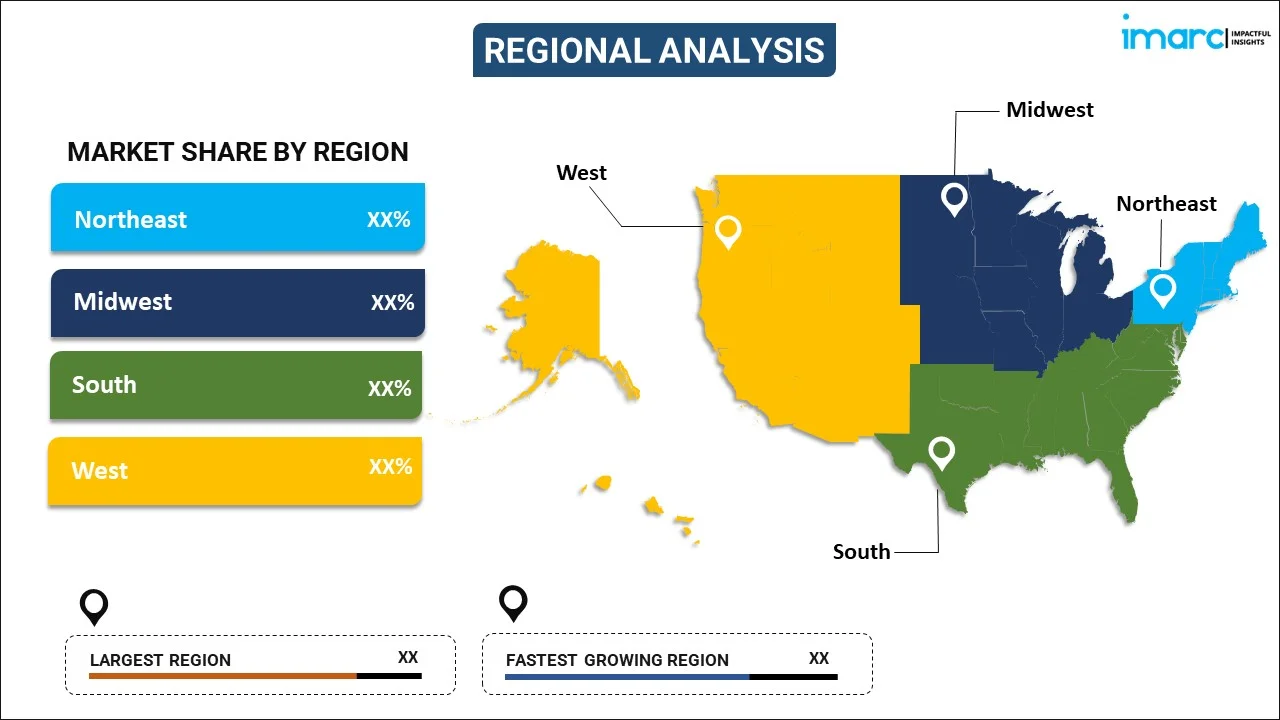
United States Pulse Oximeter Market Report by Type (Fingertip Pulse Oximeters, Handheld Pulse Oximeters, Wrist-worn Pulse Oximeters, and Others), Sensor Type (Reusable, Disposable), End Use (Hospitals and Clinics, Ambulatory Surgery Centers, Home Healthcare, and Others), and Region 2024-2032
Market Overview:
The United States pulse oximeter market size is projected to exhibit a growth rate (CAGR) of 10.20% during 2024-2032. The growing awareness about health monitoring, increasing aging population, sudden outbreak of the COVID-19 pandemic rapid advancements in technology, and the rising prevalence of chronic diseases represent some of the key factors driving the market.
|
Report Attribute
|
Key Statistics
|
|---|---|
|
Base Year
|
2023 |
|
Forecast Years
|
2024-2032 |
|
Historical Years
|
2018-2023
|
| Market Growth Rate (2024-2032) | 10.20% |
A pulse oximeter is a medical device that is used to measure the oxygen saturation level in the blood of an individual. It is a simple and non-invasive tool that has become increasingly important in healthcare settings and even in home use. The device typically consists of a small clip or probe that is placed on the fingertip, earlobe, or other thin and well-vascularized areas of an individual. By emitting two different wavelengths of light (usually red and infrared), the pulse oximeter can determine the amount of oxygen carried by hemoglobin in the blood. The principle behind a pulse oximeter is based on the fact that oxygenated hemoglobin and deoxygenated hemoglobin absorb light differently. When the device shines its light through the skin and measures the amount of light that is absorbed, it can calculate the percentage of oxygen saturation in the blood. This reading is typically displayed as a percentage, with a normal oxygen saturation level for a healthy individual being around 95% to 100%.
United States Pulse Oximeter Market Trends:
The increasing awareness about the importance of health monitoring and preventive healthcare measures has been a significant driver of the oximeter market. Individuals are becoming more proactive about monitoring their vital signs, including oxygen saturation levels, as a part of their overall well-being. Additionally, the aging demographic in the United States is a major driver. As the population continues to age, there is a higher prevalence of chronic illnesses and respiratory conditions such as COPD and sleep apnea. Oximeters play a critical role in managing and monitoring these conditions. Other than this, the COVID-19 pandemic had a profound impact on the oximeter market. Pulse oximeters became a household item as individuals sought to monitor their oxygen levels as a potential early indicator of COVID-19 infection. This surge in demand for oximeters significantly boosted the market. Besides this, the rise of telemedicine and remote patient monitoring has increased the need for accessible and accurate health monitoring devices like oximeters. Healthcare providers can remotely monitor vital signs of patients, including oxygen saturation, improving the quality of care and reducing the need for in-person visits. In line with this, the preference for home-based healthcare services is on the rise, driven by factors such as convenience and cost-effectiveness. Oximeters are now readily available for home use, enabling individuals to monitor their health from the comfort of their homes. Furthermore, the extent of health insurance coverage for oximeters and related monitoring devices plays a role in market growth. When these devices are covered by insurance plans, it makes them more accessible to a broader population. Apart from this, the overall increase in healthcare expenditure in the United States, both by individuals and the government, contributes to the growth of the medical device market, including oximeters. Moreover, the rising prevalence of chronic diseases like diabetes, hypertension, and cardiovascular conditions necessitates continuous monitoring of vital signs, including oxygen saturation. Oximeters are integral in managing these conditions and preventing complications.
United States Pulse Oximeter Market Segmentation:
IMARC Group provides an analysis of the key trends in each segment of the market, along with forecasts at the country level for 2024-2032. Our report has categorized the market based on type, sensor type, and end use.
Type Insights:

- Fingertip Pulse Oximeters
- Handheld Pulse Oximeters
- Wrist-worn Pulse Oximeters
- Others
The report has provided a detailed breakup and analysis of the market based on the type. This includes fingertip pulse oximeters, handheld pulse oximeters, wrist-worn pulse oximeters, and others.
Sensor Type Insights:
- Reusable
- Disposable
A detailed breakup and analysis of the market based on the sensor type have also been provided in the report. This includes reusable and disposable.
End Use Insights:
- Hospitals and Clinics
- Ambulatory Surgery Centers
- Home Healthcare
- Others
The report has provided a detailed breakup and analysis of the market based on the end use. This includes hospitals and clinics, ambulatory surgery centers, home healthcare, and others.
Regional Insights:

- Northeast
- Midwest
- South
- West
The report has also provided a comprehensive analysis of all the major regional markets, which include the Northeast, Midwest, South, and West.
Competitive Landscape:
The market research report has also provided a comprehensive analysis of the competitive landscape. Competitive analysis such as market structure, key player positioning, top winning strategies, competitive dashboard, and company evaluation quadrant has been covered in the report. Also, detailed profiles of all major companies have been provided.
United States Pulse Oximeter Market Report Coverage:
| Report Features | Details |
|---|---|
| Base Year of the Analysis | 2023 |
| Historical Period | 2018-2023 |
| Forecast Period | 2024-2032 |
| Units | US$ Million |
| Scope of the Report | Exploration of Historical Trends and Market Outlook, Industry Catalysts and Challenges, Segment-Wise Historical and Future Market Assessment:
|
| Types Covered | Fingertip Pulse Oximeters, Handheld Pulse Oximeters, Wrist-worn Pulse Oximeters, Others |
| Sensor Types Covered | Reusable, Disposable |
| End Uses Covered | Hospitals and Clinics, Ambulatory Surgery Centers, Home Healthcare, Others |
| Regions Covered | Northeast, Midwest, South, West |
| Customization Scope | 10% Free Customization |
| Report Price and Purchase Option | Single User License: US$ 3699 Five User License: US$ 4699 Corporate License: US$ 5699 |
| Post-Sale Analyst Support | 10-12 Weeks |
| Delivery Format | PDF and Excel through Email (We can also provide the editable version of the report in PPT/Word format on special request) |
Key Questions Answered in This Report:
- How has the United States pulse oximeter market performed so far and how will it perform in the coming years?
- What has been the impact of COVID-19 on the United States pulse oximeter market?
- What is the breakup of the United States pulse oximeter market on the basis of type?
- What is the breakup of the United States pulse oximeter market on the basis of sensor type?
- What is the breakup of the United States pulse oximeter market on the basis of end use?
- What are the various stages in the value chain of the United States pulse oximeter market?
- What are the key driving factors and challenges in the United States pulse oximeter?
- What is the structure of the United States pulse oximeter market and who are the key players?
- What is the degree of competition in the United States pulse oximeter market?
Key Benefits for Stakeholders:
- IMARC’s industry report offers a comprehensive quantitative analysis of various market segments, historical and current market trends, market forecasts, and dynamics of the United States pulse oximeter market from 2018-2032.
- The research report provides the latest information on the market drivers, challenges, and opportunities in the United States pulse oximeter market.
- Porter's five forces analysis assist stakeholders in assessing the impact of new entrants, competitive rivalry, supplier power, buyer power, and the threat of substitution. It helps stakeholders to analyze the level of competition within the United States pulse oximeter industry and its attractiveness.
- Competitive landscape allows stakeholders to understand their competitive environment and provides an insight into the current positions of key players in the market.
Need more help?
- Speak to our experienced analysts for insights on the current market scenarios.
- Include additional segments and countries to customize the report as per your requirement.
- Gain an unparalleled competitive advantage in your domain by understanding how to utilize the report and positively impacting your operations and revenue.
- For further assistance, please connect with our analysts.
 Inquire Before Buying
Inquire Before Buying
 Speak to an Analyst
Speak to an Analyst
 Request Brochure
Request Brochure
 Request Customization
Request Customization




.webp)




.webp)












